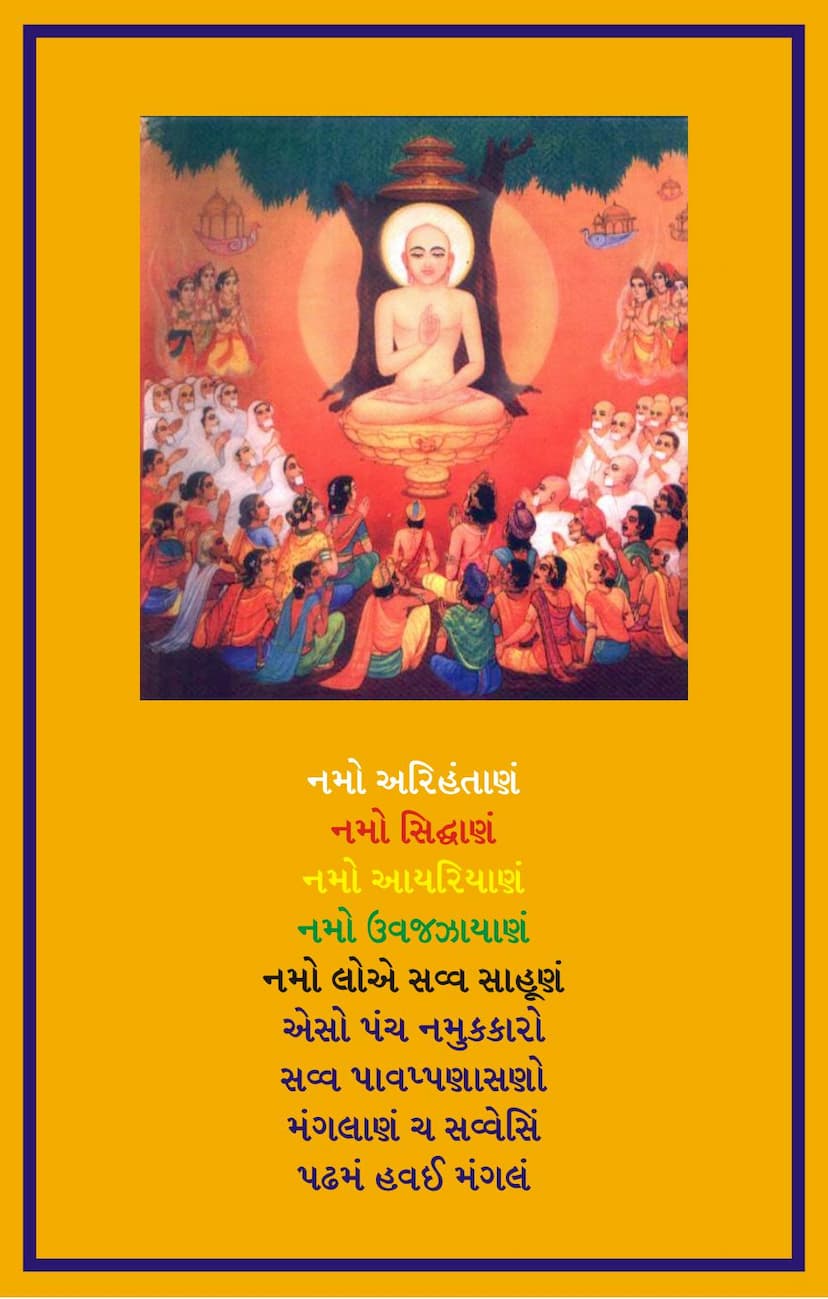Agam 14 Upang 03 Jivabhigam Sutra Part 01 Sthanakvasi Gujarati
Added to library: September 1, 2025

Summary
Here's a comprehensive summary of the provided Jain text, "Agam 14 Upang 03 Jivabhigam Sutra Part 01 Sthanakvasi Gujarati," focusing on the content presented:
Book Title: Agam 14 Upang 03 Jivabhigam Sutra Part 01 Author: Ghasilal Maharaj Publisher: A B Shwetambar Sthanakvasi Jain Shastroddhar Samiti
Overall Summary:
This text, the first part of the Jivabhigam Sutra from the Jain Agamas, is a detailed exposition of the principles of Jainism, particularly focusing on the nature and classifications of living beings (Jiva) and non-living beings (Ajiva). The text, presented in Gujarati with commentary by Ghasilal Maharaj, meticulously outlines the various aspects of existence, the cycle of birth and death (samsara), and the path to liberation (moksha).
Key Themes and Content:
-
Mangalacharan (Invocation): The text begins with a traditional invocation, praising the Arihants, Siddhas, Acharyas, Upadhyayas, and Sadhus, acknowledging the Panch Namaskar Mantra as the destroyer of sins and the supreme auspicious beginning.
-
Instructions for Study (Swadhyaya): A significant portion of the initial pages is dedicated to detailed instructions regarding the proper times and circumstances for studying the original text (Moolpath). These instructions include:
- Timing: Specific times of day and night are recommended for recitation.
- Prohibited Times: Certain periods like dawn, dusk, noon, and midnight are to be avoided for specific durations.
- Aswadhyaya (Times of Non-Study): A comprehensive list of 32 situations where study is prohibited is provided, categorized into:
- 10 based on Sky (Akash): Events like meteor showers, directional fires, thunder, lightning, eclipses, and heavy fog/mist are listed as times of non-study.
- 10 based on the Physical Body (Audarik Sharir): This includes encountering remains of bones, flesh, or blood, dealing with excreta, being near a cremation ground, handling broken eggs, and the presence of a dead body within or near the place of study.
- 8 based on Festivals and Special Days: These include specific full moon festivals and the subsequent days (Pratipada).
- Flexibility: The text notes that these Aswadhyaya rules are for the original text and not strictly for translations. It emphasizes the importance of adhering to the guidance of elders and gurus during challenging times.
-
Content Outline (Anukramanika): A table of contents is provided, listing the various topics and "doors" (dwara) or aspects that will be discussed. This includes:
- The nature of Jivabhigam and Ajivabhigam.
- Discussions on various attributes of souls (Jiva) and non-souls (Ajiva), such as body types, spatial dimensions, structure, constitution, sensory organs, psychic modifications (samudghat), consciousness (samjnya), passions (kashay), senses (indriya), states of existence (ved), faculties (lapsi), lifespan (sthiti), transmigration (chyavan), movement (gati-agari), and the various types of souls based on their physical forms and realms (e.g., Earth-bodied, Water-bodied, Plant-bodied, Two-sensed, Three-sensed, Four-sensed, Five-sensed beings, including human and celestial beings).
- Detailed classifications of various types of beings, particularly focusing on subtle and gross classifications (Sukshma and Badar) of Earth-bodied beings (Prithvi Kayik) and their respective characteristics.
- Discussions on the attributes of beings across different realms (hellish beings, animals, humans, and celestials).
- The concept of lifespan (bhavasthiti) and its variations across different species and realms.
- The concept of male, female, and neuter genders (Veda) and their prevalence.
-
Detailed Exposition of Jain Concepts: The core of the text delves into intricate classifications and details of Jain philosophy, illustrated through questions posed by Gautam Swami to Lord Mahavir. These discussions cover:
- Jiva and Ajiva: The fundamental distinction between living and non-living substances.
- Classifications of Beings: Extensive categorization of souls based on the number of senses (ekendriya, dvindriya, trindriya, chaturindriya, panchendriya), the type of body (audarik, vaikriya, ahara), the realm of existence (hell, animal, human, celestial), and the presence or absence of consciousness (sanjnya).
- Attributes: Detailed explanations of attributes like lifespan (sthiti), passion (kashay), sensory organs (indriya), states of consciousness (leshya), karma (bandh), transmigration (chayvan), origin (upapat), and movement (gati-agari).
- Specific Beings: In-depth analyses of various categories, starting with the subtle and gross Earth-bodied beings, then moving to water-bodied, fire-bodied, air-bodied, plant-bodied, and finally the trasa (mobile) beings (two-sensed, three-sensed, four-sensed, and five-sensed). This includes detailed classifications within each category, for instance, the different types of hellish beings, celestial beings, and the various types of mobile beings.
- Gender and Lifespan: The text also discusses the lifespan and characteristics related to male, female, and neuter beings across different categories, and the lifespan of celestial beings and their subdivisions.
Significance of the Jivabhigam Sutra:
The Jivabhigam Sutra is considered a crucial text in Jainism for its exhaustive description of the nature and manifold forms of souls. It provides a deep understanding of the karmic principles that bind souls to the cycle of rebirth and the path to achieve liberation. The detailed classifications help disciples understand the complexities of samsara and the diverse forms of existence, reinforcing the Jain emphasis on non-violence (ahimsa) towards all living beings.
In essence, this part of the Jivabhigam Sutra serves as a foundational text for understanding the Jain cosmology and the detailed principles governing the existence and transmigration of souls.